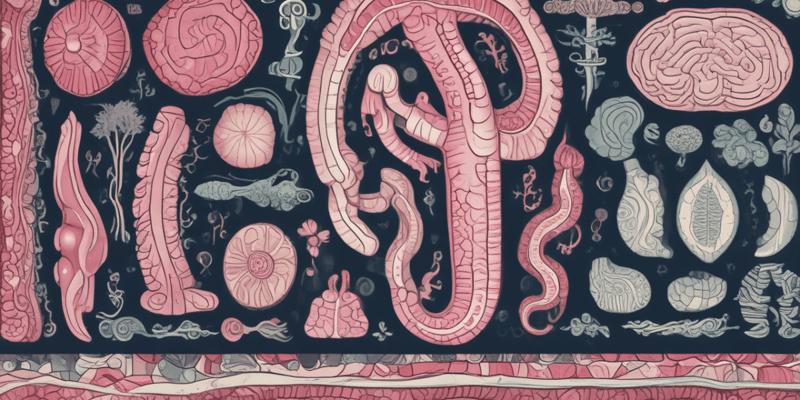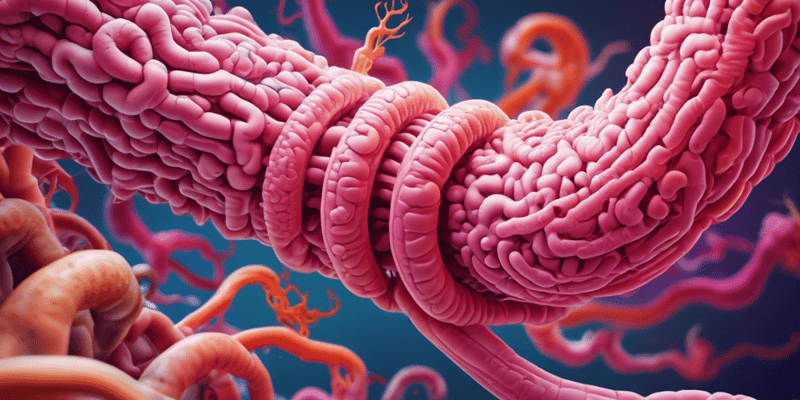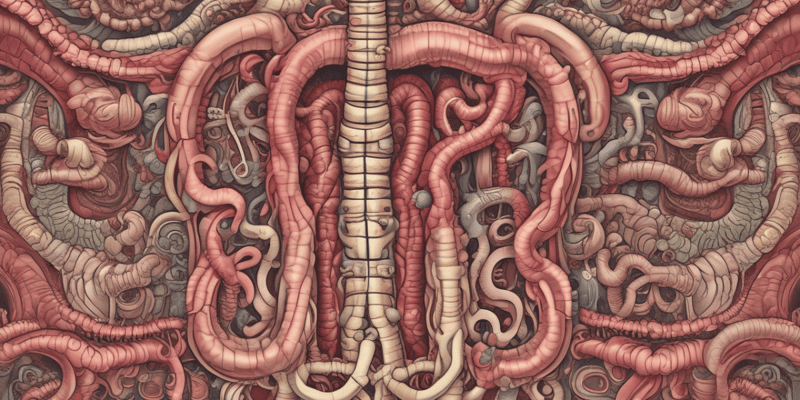Questions and Answers
Which cells are responsible for the secretion of hydrochloric acid in the stomach?
Parietal cells
Which enzyme is secreted by chief cells in the stomach?
Pepsinogen
Which hormone is responsible for causing contraction of the gallbladder to expel bile into the cystic duct?
Cholecystokinin
Which process aids in the mixing of digestive juices and food in the stomach?
Signup and view all the answers
Which organ produces bile salts that emulsify fats and help in fat and cholesterol absorption?
Signup and view all the answers
Which enzyme is responsible for the breakdown of nucleic acids (DNA/RNA) in the small intestine?
Signup and view all the answers
Which of the following cells in the small intestine are responsible for secreting mucus?
Signup and view all the answers
What is the role of the gallbladder in the digestive process?
Signup and view all the answers
Which of the following hormones is produced by enteroendocrine cells in the small intestine?
Signup and view all the answers
Which part of the small intestine is mainly responsible for chemical digestion and nutrient absorption?
Signup and view all the answers
What is the approximate length of the jejunum in the small intestine?
Signup and view all the answers
What is the primary function of the hydrochloric acid secreted by parietal cells in the stomach?
Signup and view all the answers
What is the role of chief cells in the stomach?
Signup and view all the answers
What is the result of stretch distention in the duodenum during the intestinal phase?
Signup and view all the answers
What is the function of intrinsic factor secreted by parietal cells?
Signup and view all the answers
What is the result of segmentation in the small intestine?
Signup and view all the answers
What is the result of gastrin secretion?
Signup and view all the answers
What is the role of parietal cells in the stomach?
Signup and view all the answers
During which phase is the enterogastric reflex triggered?
Signup and view all the answers
What is the function of intrinsic factor secreted by parietal cells?
Signup and view all the answers
Which enzyme is produced by chief cells in the stomach and activated by hydrochloric acid?
Signup and view all the answers
What is the result of gastrin secretion in the digestive process?
Signup and view all the answers
Which cells secrete an acidic mucus in the stomach?
Signup and view all the answers
Which cells in the stomach are responsible for the secretion of intrinsic factor, required for the absorption of vitamin B12?
Signup and view all the answers
Which process results in the conversion of inactive pepsinogen to active pepsin in the stomach?
Signup and view all the answers
Which hormone is primarily responsible for causing the gallbladder to contract and expel bile into the cystic duct?
Signup and view all the answers
Which cells in the small intestine produce the hormone secretin, which stimulates the release of bicarbonate-rich pancreatic juice?
Signup and view all the answers
Which of the following processes is responsible for mixing digestive juices and food in the stomach?
Signup and view all the answers
What is the function of bile salts in the digestive process?
Signup and view all the answers
Which cells in the pancreas secrete pancreatic juice with HCO₃⁻?
Signup and view all the answers
What is the result of the breakdown of bilirubin in the small intestine?
Signup and view all the answers
What is the function of cholecystokinin (CCK) in the digestive process?
Signup and view all the answers
What is the role of the colon in the digestive process?
Signup and view all the answers
What is the function of pancreatic amylase in the digestive process?
Signup and view all the answers
Study Notes
Digestive Process
- Cephalic phase: occurs before food enters the stomach, triggered by aroma, taste, sight, and thought of food
- Gastric phase: when food enters the stomach, lasts 3-4 hours, and provides about two-thirds of the gastric juice released
- Intestinal phase: triggered by distention of the duodenum when chyme enters, inhibits gastrin production and gastric contractions
Stomach
- Gastric contractions:
- Mix food with gastric juices to form chyme
- Peristaltic wave reaches pyloric sphincter
- Contractions cause stomach to empty contents into duodenum
- Cells of the stomach:
- Mucous neck cells: secrete an acidic mucus
- Parietal cells: secrete hydrochloric acid and intrinsic factor
- Chief cells: produce pepsinogen, which is activated by HCl to form pepsin
- Gastric emptying:
- Usually occurs four hours after meal
- Large meals with more liquid cause the stomach to empty quicker
- Stretch and chemical signals in duodenum affect the rate of gastric emptying
Small Intestine
- Segmentation: rhythmic local contractions of small intestines
- Absorption: passage of digested food end products to blood or lymph
- Divisions of small intestine:
- Duodenum: 10 inches in length, receives digestive secretions from liver and pancreas
- Jejunum: 8.2 ft long, supported by sheet of mesentery, most chemical digestion and nutrient absorption occurs here
- Ileum: 11.5 ft long, final segment of small intestines
- Cells of the epithelium:
- Mainly columnar: absorptive cells bound by tight junctions
- Goblet cells: secrete mucus
- Enteroendocrine cells: source of entergastrones, secretin, and cholecystokinin (CCK)
Liver and Gallbladder
- Liver:
- Produces bile for export to the duodenum
- Bile is a fat emulsifier
- Gallbladder:
- Stores and concentrates bile
- Bile enters cystic duct, then common bile duct
- Relationship of liver, gallbladder, and pancreas to the duodenum
Studying That Suits You
Use AI to generate personalized quizzes and flashcards to suit your learning preferences.
Description
Learn about the anatomy of the small intestine, including its three divisions (duodenum, jejunum, ileum) and their functions in digestion and nutrient absorption.




